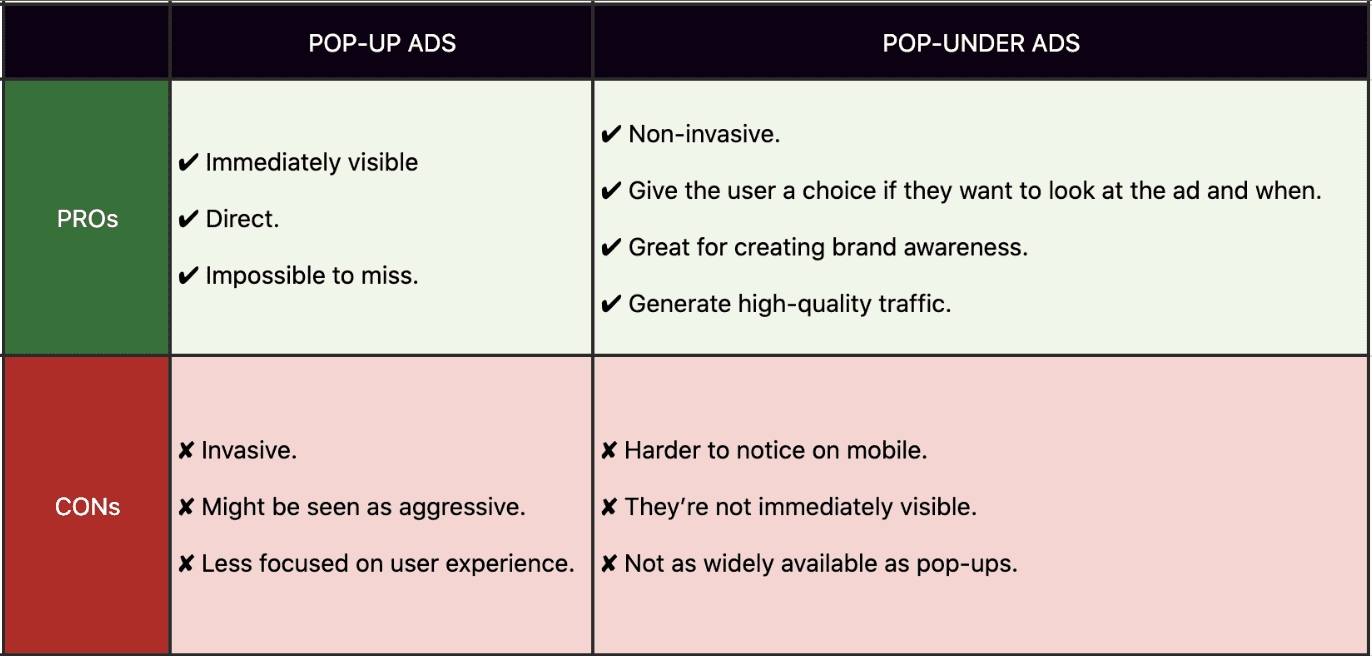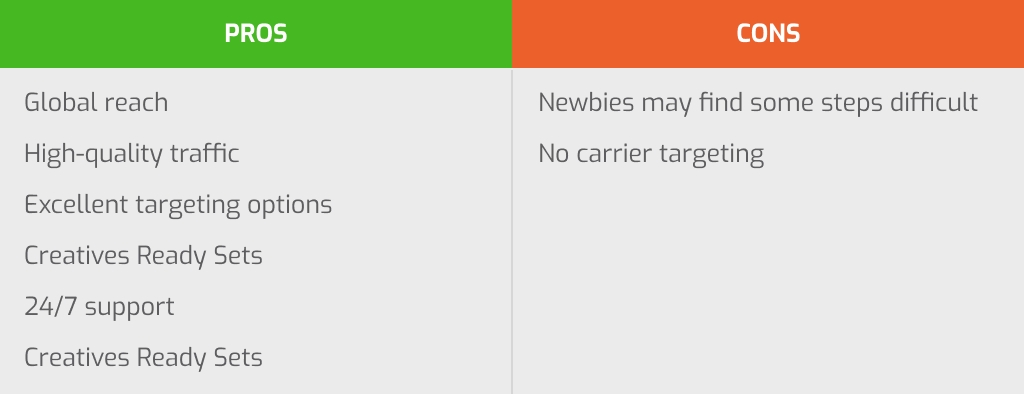Balancing Efficiency and Irritation
Buy CPC Traffic | Buy Display Ads | Exclusive traffic sources | Buy Push Ads | Popunder ADS | Buy Native Ads | Buy Preroll Ads

Buy CPC Traffic | Buy Display Ads | Exclusive traffic sources | Buy Push Ads | Popunder ADS | Buy Native Ads | Buy Preroll Ads
In the world of digital marketing, pop ad networks are a popular and controversial advertising method. Pop ads are those annoying windows that suddenly appear on your screen while browsing a website or using an app. Some people find them highly effective in capturing attention and driving conversions, while others consider them obtrusive and intrusive.
On one hand, pop ad networks offer significant advantages. They have a high reach and can potentially expose your brand to a large audience. Pop ads are especially effective in driving immediate actions, such as sign-ups, downloads, or purchases. Their intrusive nature ensures that users notice them, which can increase the chances of engagement and conversion.
On the other hand, there are several drawbacks to consider. Pop ads can disrupt the user experience, causing frustration and annoyance. They can slow down website loading times and even lead to a higher bounce rate. Additionally, pop ads can damage a brand's reputation, as users may associate the intrusive advertising with a lack of professionalism or trustworthiness.
Ultimately, the effectiveness of pop ad networks depends on various factors. The industry, target audience, and advertising strategy all play a crucial role in determining whether pop ads are a good fit for your business. It's essential to weigh the potential benefits against the possible negative effects and thoroughly evaluate whether pop ad networks align with your marketing objectives and brand image.
In conclusion, pop ad networks can be both effective and annoying. They have the potential to reach a wide audience and drive immediate actions, but they may also disrupt user experience and cause frustration. To make an informed decision, it's important to carefully consider the pros and cons of pop ad networks and evaluate whether they align with your business goals and target audience preferences.
Exploring the Pros and Cons of Pop Ad Networks
Pop ad networks are a common form of online advertising that utilizes pop-up or pop-under ads to capture the attention of website visitors. These networks have both advantages and disadvantages, which should be carefully considered before implementing them into an advertising strategy.
Pros:
1. Increased visibility: Pop ads are often impossible to ignore, making them highly visible to website visitors. This can help in promoting brand awareness and attracting potential customers.
2. Enhanced targeting options: Pop ad networks usually offer advanced targeting options that allow advertisers to narrow down their audience based on demographics, interests, and behavior. This can result in higher conversion rates and a higher return on investment.
3. Higher engagement rates: Pop ads can be effective in grabbing the attention of users and encouraging them to take action, such as clicking on the ad or visiting the advertiser's website. This can lead to higher engagement rates compared to other forms of advertising.
Cons:
1. User experience: Pop ads can interrupt the user experience and be perceived as intrusive or annoying. This can negatively impact the reputation of the website where the ads are displayed and lead to a higher bounce rate.
2. Ad-blocking software: Many internet users utilize ad-blocking software to avoid pop-up ads and other types of intrusive advertising. This can significantly reduce the reach and effectiveness of pop ad networks.
3. Quality concerns: Pop ad networks are often associated with lower-quality ads, such as those promoting scammy products or misleading content. This can damage the credibility of an advertiser and lead to a negative perception of their brand.
In conclusion, pop ad networks can offer increased visibility, enhanced targeting options, and higher engagement rates. However, they also come with drawbacks such as negative user experience, ad-blocking software, and potential quality concerns. It is essential for advertisers to carefully evaluate these pros and cons and consider alternative advertising methods before deciding to utilize pop ad networks.
Understanding Pop Ad Networks
Pop ad networks are a form of online advertising that involves displaying ads in small windows or pop-ups that appear over or under a website's content. These ads are typically triggered when a user clicks on a link or visits a specific webpage.
Pop ad networks work by utilizing scripts that allow advertisers to display their ads on third-party websites. When a user visits a website that participates in a pop ad network, the script triggers the display of an ad, usually in a separate browser window or tab.
Pros of Pop Ad Networks

One of the main advantages of pop ad networks is their high visibility. Since the ads appear in separate windows, they are difficult for users to ignore, increasing the chances that they will see and engage with the ad.
Pop ad networks also offer advertisers a cost-effective way to reach a wide audience. Compared to other advertising methods, pop ad networks often have lower costs per click or impression, making them an attractive option for advertisers on a budget.
Lastly, pop ad networks can provide advertisers with valuable targeting options. Advertisers can specify the types of websites or audiences they want their ads to appear to, allowing them to reach a more relevant audience and increase the likelihood of conversion.
Cons of Pop Ad Networks

While pop ad networks have their advantages, they also come with some drawbacks. One of the main concerns with pop ad networks is their potential to disrupt the user experience. Pop-ups can be seen as intrusive and annoying, potentially driving users away from a website and negatively impacting the overall user experience.
Another issue with pop ad networks is their reputation for displaying low-quality or misleading ads. Some pop ad networks have been associated with ads that contain malware or deceptive content, which can harm a user's device or compromise their privacy.
Lastly, pop ad networks have faced criticism for their lack of transparency and control. Advertisers do not always have full visibility into where their ads are being displayed, which can lead to concerns about brand safety and ad placement.
Overall, pop ad networks can be an effective advertising method when used appropriately. They offer high visibility and targeting options at a lower cost, but it is important for advertisers to carefully consider the potential impact on the user experience and ensure the ads are of high quality and relevant to the target audience.
Effectiveness of Pop Ad Networks
Pop ad networks have gained popularity in the digital advertising world due to their ability to reach a wide audience and generate significant traffic for businesses. However, their effectiveness can vary depending on several factors.
Pros of Pop Ad Networks
1. Wide Reach: Pop ad networks have the potential to reach a large number of internet users across various websites and platforms. This helps businesses increase their brand visibility and reach a broader audience.
2. Cost-Effectiveness: Compared to other forms of digital advertising, pop ad networks can be relatively affordable. Businesses have the flexibility to set their budget and control their spending.
3. Increased Click-through Rates: Pop ad networks often generate higher click-through rates (CTRs) compared to other forms of online advertising. This can be attributed to their intrusive nature, which captures users' attention and compels them to click on the ads.
Cons of Pop Ad Networks
1. Intrusion and Annoyance: Pop ads can be seen as intrusive and annoying to some internet users. They disrupt the browsing experience and can negatively impact user satisfaction.
2. Quality Concerns: Pop ad networks are often associated with low-quality ads and clickbait content. This can harm a business's reputation and result in a negative perception of the brand.
3. Ad Blocking: With the rise of ad blockers, many internet users are blocking pop ads altogether. This reduces the effectiveness of pop ad networks as a means of reaching potential customers.
In conclusion, while pop ad networks have their advantages in terms of reach, cost-effectiveness, and click-through rates, there are also concerns regarding their intrusion, annoyance, and quality. To ensure the effectiveness of pop ad networks, businesses must carefully consider their target audience and use strategies such as buying traffic to ensure they reach the right users with relevant and engaging content.
Annoyance Factor of Pop Ad Networks

While pop ad networks can be effective in reaching a wide audience and generating traffic for websites, they are often regarded as annoying by internet users. There are several reasons why pop ad networks have an annoyance factor:
1. Intrusiveness
Pop-up ads are known for their intrusive nature. They appear unexpectedly in a new window or tab, disrupting the user's browsing experience. This interruption can be especially frustrating when pop-ups appear repeatedly or cannot be easily closed.
2. Disrupting content consumption

One of the main drawbacks of pop ad networks is that they disrupt the user's ability to consume content on a website. Pop-ups cover the main content, requiring users to close them before accessing the desired information. This can be time-consuming and irritating, leading to a negative perception of the website and the advertiser.
In some cases, pop-ups may also interfere with the functionality of a website, causing errors or slowdowns. This can further hamper the user experience and increase annoyance levels.
3. Irrelevance
Another factor that contributes to the annoyance of pop ad networks is the lack of relevance in the ads displayed. Users often encounter pop-ups that are not aligned with their interests or browsing context, making them feel like a distraction rather than a useful addition. This lack of relevance can reduce the credibility of the advertiser and diminish the effectiveness of the ad.
Overall, the annoyance factor of pop ad networks should not be underestimated. While they may have potential benefits for advertisers, it is important to carefully consider the user experience and minimize the negative impact on website visitors.
Benefits of Pop Ad Networks
Pop ad networks have gained popularity among advertisers and publishers due to several key benefits:
1. High Visibility: Pop ads appear in a new window or tab, capturing the attention of users. This increased visibility can lead to higher click-through rates and conversions.
2. Targeted Reach: Pop ads can be targeted based on a variety of factors, including demographics, interests, and browsing behavior. This allows advertisers to reach a specific audience, increasing the chances of ad relevance and engagement.
3. Cost-effective: Pop ad networks often offer competitive pricing options, making them an attractive option for advertisers with a limited budget. The ability to set the daily budget and adjust bids allows for better control over advertising costs.
4. Wide Network: Pop ad networks typically have a large network of publishers, giving advertisers access to a wide range of websites and apps. This broad reach can help increase brand exposure and drive traffic to advertisers' websites.
5. Quick Turnaround: Pop ad campaigns can be launched quickly and easily, without the need for extensive creative resources or lengthy approval processes. This makes pop ad networks a convenient option for advertisers looking for immediate results.
6. Flexibility: Pop ad networks offer flexible advertising options, allowing advertisers to choose the desired ad format, frequency, and display duration. This gives advertisers the freedom to create campaigns that align with their marketing objectives and target audience.
Despite these benefits, it is important to consider the potential drawbacks and user experience impact of pop ad networks before deciding to use them in a digital advertising strategy.
Drawbacks of Pop Ad Networks
While pop ad networks can offer benefits for advertisers and publishers, there are also several drawbacks associated with this type of advertising.
1. Intrusive User Experience
Perhaps the most significant drawback of pop ad networks is the intrusive user experience they provide. Pop-up and pop-under ads can interrupt the user's browsing experience, often appearing suddenly and covering the content they are trying to view. This can be frustrating and annoying for users, leading to negative perceptions of both the ad and the website displaying it.
2. Decreased User Trust and Engagement
Pop ad networks are often seen as untrustworthy and spammy by internet users. This negative perception can lead to a decrease in user trust in the advertised brand and the website displaying the pop ad. Users may be less likely to engage with the ad or click on it, resulting in lower conversion rates for advertisers.
3. Ad Blindness

Due to the prevalence of pop ads, users have become increasingly accustomed to ignoring or closing them without paying much attention. This phenomenon, known as ad blindness, can significantly impact the effectiveness of pop ad networks. Advertisements that are not seen or engaged with are unlikely to generate the desired results and return on investment for advertisers.
4. Ad Blocking Software

In response to the annoyance caused by pop ad networks, many internet users have started using ad-blocking software to block these types of ads altogether. This presents a major challenge for advertisers who rely on pop ad networks to reach their target audience. As more people adopt ad-blocking tools, the reach and effectiveness of pop ads continue to decline.
5. Negative Impact on Website Performance
Pop ad networks can have a negative impact on website performance. These ads often require additional loading time and resources, slowing down the website and causing a poor user experience. Slow-loading websites can lead to increased bounce rates, lower search engine rankings, and reduced overall site performance.
Overall, while pop ad networks offer a way to reach a large audience quickly, they come with several drawbacks that can negatively impact both advertisers and users. It is essential for advertisers and publishers to carefully consider these drawbacks and weigh them against the potential benefits before deciding to utilize pop ad networks as part of their advertising strategy.
What are pop ad networks?
Pop ad networks are advertising networks that display pop-up or pop-under ads on websites. These ads typically open in a new browser window or tab and grab the attention of the user.
Do pop ad networks really work?
Pop ad networks can be effective in generating website traffic and increasing brand awareness, as they have the ability to reach a large audience. However, their effectiveness can vary depending on the target audience and the quality of the ads being displayed.
What are the pros of using pop ad networks?
Pop ad networks offer several benefits, such as the ability to reach a wide audience, generate website traffic, and increase brand visibility. They are also relatively low-cost compared to other forms of advertising, making them attractive to advertisers with a limited budget.
Are pop ads annoying to users?
Pop ads can be annoying to some users, as they can interrupt the browsing experience and be seen as intrusive. However, this annoyance can be minimized if the ads are relevant, non-intrusive, and not excessive in their frequency.
What are the cons of using pop ad networks?
While pop ad networks have their advantages, there are also several drawbacks to consider. These include the potential annoyance to users, the risk of generating low-quality traffic, and the possibility of damaging the brand reputation if the ads are poorly designed or irrelevant.
What are pop ad networks?
Pop ad networks are advertising platforms that deliver pop-up ads to users while they are browsing websites or using mobile apps. These ads usually appear in a new window or tab and can be either full-screen or smaller overlays.
Are pop ad networks effective for advertisers?
Pop ad networks can be effective for advertisers because they can reach a large audience and generate high click-through rates. They are also generally more cost-effective compared to other forms of online advertising.
Buy CPC Traffic | Buy Display Ads | Exclusive traffic sources | Buy Push Ads | Popunder ADS | Buy Native Ads | Buy Preroll Ads
2022-2024 @ Exploring the Pros and Cons of Pop Ad Networks: Are they Effective or Annoying?